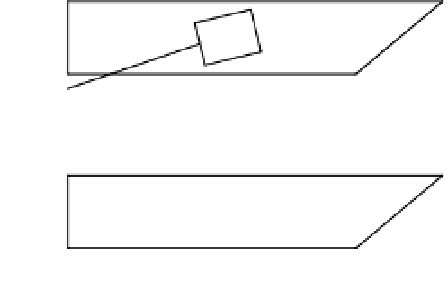Game Development Reference
In-Depth Information
Figure 9-5.
Drive system types
Because the weight of the engine is moved forward and because the propeller thrust is
directed upward with the direct drive system, a direct drive boat will have a lower planing angle
at high speed and will experience more hull drag.
The most commonly used type of drive system with modern, planing powerboats is the
stern drive
and is also shown in Figure 9-5. The engine is located inside the hull and is placed
very close to the transom (the aft end of the hull). The drive shaft goes through the transom into
a gearbox located outside the hull aft of the transom. The engine torque is transmitted down-
ward to the propeller shaft located below the gearbox. The stern drive is also known as an
Inboard/Outboard
(I/O) drive system because some of the drive components are inside the
hull and some are outside.
The angle of the propeller shaft in a stern drive can be rotated somewhat up or down to
make it easier for the boat to plane and to reduce hull drag at high speeds. Stern drives are also
more maneuverable than direct drives because the boat can be turned by rotating the propeller
shafts from side to side. Because the engine torque must pass through two 90-degree gear-
boxes to reach the propeller shaft, a stern drive is somewhat less efficient than a direct drive.
A stern drive is also more complicated mechanically than a direct drive and is therefore more
prone to failure.
In addition to direct drive and stern drive systems, there are other drive system configura-
tions that have been developed over the years including
Vee drives
and
surface drives
. These
are inboard drive systems that involve different configurations of the engine, gearbox, and
shafts. There are also
outboard drive
systems where the engine and propeller are located at the
stern of the boat outside of the hull.
Another completely different type of drive system is a
jet drive
system. Rather than a mechan-
ical drive system based on turning drive and propeller shafts, a jet drive works as a powerful,
engine-driven water pump. Water is sucked in through an opening in the bottom of the boat
and shot out at high velocities through a nozzle at the stern. The nozzle discharge provides the
propulsion for the boat. Jet drives are used for some types of powerboats and are widely used
with jet skis, a topic that will be explored in more detail later in this chapter.
Propeller Basics
The purpose of the drive system of a boat is to transfer the torque from the boat's engine to the
propeller. When the propeller (also known as the screw) turns, thrust is generated that propels





